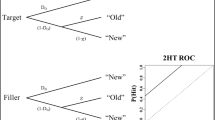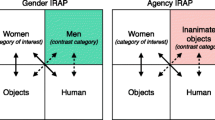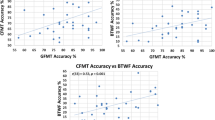Abstract
Male subjects learned that they would have to perform an easy, moderately difficult, or very difficult memory task in order to qualify for a “learning session” in which they would be accompanied by a moderately attractive female. Subjective measures taken just prior to task performance indicate that subjects viewed the female target as more attractive, sexy, and cute in the Moderately Difficult task condition than in the Easy and Very Difficult task conditions. Results are discussed in terms of a recently proposed model of motivation (Brehm 1979; Brehm, Wright, Solomon, Silka, & Greenberg, 1983), and research on the relation between difficulty and interpersonal attraction.
Similar content being viewed by others
References
Atkinson, J. W. (1957). Motivational determinants of risk-taking behavior.Psychological Review, 64 359–372.
Berscheid, E., & Walster, E. (1974). A little bit about love. In T. Huston (Ed.),Foundations of interpersonal attraction. New York: Academic Press.
Brehm, J. W. (1966).A theory of psychological reactance. New York: Academic Press.
Brehm, J. W. (1979).Perceived difficulty and energization. Grant proposal (Department of Psychology, University of Kansas, Lawrence, Kansas 66045).
Brehm, J. W., & Cohen, A. R. (1962).Explorations in cognitive dissonance. New York: Wiley.
Brehm, J. W., Vought, C., & Pyszczynski, T. (1984).Energization and consequent goal attractiveness as a function of perceived difficulty of a motor task. Unpublished manuscript, University of Kansas.
Brehm, J. W., Wright, R. A., Solomon, S., Silka, L., & Greenberg, J. (1983). Perceived difficulty, energization, and the magnitude of goal valence.Journal of Experimental Social Psychology, 19 21–48.
Brehm, S. S., & Brehm, J. W. (1981).Psychological reactance: A theory of freedom and control. New York: Academic Press.
Cantor, J. R., Bryant, J., & Zillmann, D. (1974). Enhancement of humor appreciation by transferred excitation.Journal of Personality and Social Psychology, 30 812–821.
Cantor, J. R., Zillmann, D., & Bryant, J. (1975). Enhancement of experienced sexual arousal in response to erotic stimuli through misattribution of unrelated residual excitation.Journal of Personality and Social Psychology, 32 69–75.
Carmer, S. G., & Swanson, M. R. (1973). An evaluation of ten pairwise multiple comparison procedures by Monte Carlo methods.Journal of the American Statistical Association, 68 66–74.
Contrada, R. J., Glass, D. C., Krakoff, L. R., Krantz, D. S., Kehoe, K., Isecke, W., Collins, C., & Elting, E. (1982). Effects of control over aversive stimulation and Type A behavior on cardiovascular and plasma catecholamine responses.Psychophysiology, 19 408–419.
Contrada, R. J., Wright, R. A., & Glass, D. C. (1984). Task difficulty, Type A behavior pattern, and cardiovascular response.Psychophysiology, 19 408–419.
Driscoll, R., Davis, K. E., & Lipetz, M. E. (1972). Parental interference and romantic love: The Romeo and Juliet effect.Journal of Personality and Social Psychology, 24 1–10.
Dutton, D., & Aron, A. (1974). Some evidence for heightened sexual attraction under conditions of high anxiety.Journal of Personality and Social Psychology, 30 510–517.
Elliott, R. (1969). Tonic heart rate: Experiments on the effect of collative variables lead to a hypothesis about its motivational significance.Journal of Personality and Social Psychology, 12 211–228.
Festinger, N. T. (1957).A theory of cognitive dissonance. Stanford: Stanford University Press.
Jecker, J. D. (1964). The cognitive effects of conflict and dissonance. In L. Festinger (Ed.),Conflict, decision, and dissonance. Stanford: Stanford University Press.
Kendrick, D. T., & Cialdini, R. B. (1977). Romantic attraction: Misattribution versus reinforcement explanations.Journal of Personality and Social Psychology, 35 381–391.
Kendrick, D. T., Cialdini, R. B., & Linder, D. E. (1979). Misattribution under fear-producing circumstances: Four failures to replicate.Personality and Social Psychology Bulletin, 5 329–334.
Kukla, A. (1972). Foundations of an attributional theory of performance.Psychological Review, 79 454–470.
Light, K. C., & Obrist, P. (1980). Cardiovascular response to stress: Effects of the opportunity to avoid shock, shock experience, and performance feedback.Psychophysiology, 17 243–252.
Light, K. C., & Obrist, P. (1983). Task difficulty, heart rate reactivity, and cardiovascular responses to an appetitive reaction time task.Psychophysiology, 20 301–312.
Manuck, S. B., Harvey, S. H., Lechleiter, S. L., & Neal, K. S. (1978). Effects of coping on blood pressure responses to threat of aversive stimulation.Psychophysiology, 15 544–549.
Matthews, K. A., Rosenfield, D., & Stephan, W. G. (1979). Playing hard to get: A two determinant model.Journal of Research in Personality, 13 234–244.
Obrist, P. A., Gaebelein, C. J., Teller, E. S., Langer, A. W., Grignolo, A., Light, K. C., & McCubbin, J. A. (1978). The relationship among heart rate, carotid dP/dt, and blood pressure in humans as a function of type of stress.Psychophysiology, 15 102–115.
Pennebaker, J. W., Dyer, M. A., Caulkins, R. S., Litowitz, D. L., Ackreman, P. L., Anderson, D. B., & McGraw, K. M. (1979). Don't the girls all get prettier at closing time: A country and western application to psychology.Personality and Social Psychology Bulletin, 5 122–125.
Schachter, S., & Singer, J. (1962). Cognitive, social, and physiological determinants of emotional state.Psychological Review, 69 379–399.
Solomon, S., Holmes, D., & McCaul, K. D. (1980). Behavioral control over aversive events: Does control that requires effort reduce anxiety and physiological rousal?Journal of Personality and Social Psychology, 39 729–736.
Trope, Y., & Brickman, P. (1975). Difficulty and diagnosticity as determinants of choice among tasks.Journal of Personality and Social Psychology, 31 918–925.
Walster, E. (1971). Passionate love. In B. I. Murstein (Ed.),Theories of attraction and love. New York: Springer.
Walster, E., Walster, G. W., Piliavin, J., & Schmidt, L. (1973). “Playing hard to get”: Understanding an elusive phenomenon.Journal of Personality and Social Psychology, 26 113–121.
White, G. L., Fishbein, S., & Rutstein, J. (1981). Passionate love and the misattribution of arousal.Journal of Personality and Social Psychology, 41 56–62.
Wicklund, R. A. (1974).Freedom and reactance. Hillsdale, New Jersey: Erlbaum.
Wicklund, R. A., & Brehm, J. W. (1976).Perspectives on cognitive dissonance. Hillsdale, New Jersey: Erlbaum.
Wright, R. A. (1982). Perceived motivational arousal as a mediator of the magnitude of goal valence.Motivation and Emotion, 6 161–180.
Wright, R. A. (1984). Motivation, anxiety, and the difficulty of avoidant control.Journal of Personality and Social Psychology, 46 1376–1388.
Wright, R. A., & Brehm, J. W. (1984). The impact of task difficulty upon perceptions of arousal and goal attractiveness in an avoidance paradigm.Motivation and Emotion, 8 171–181.
Wright, R. A., Contrada, R. J., & Patane, M. J. (in press). Task difficulty, cardiovascular response, and the magnitude of goal valence.Journal of Personality and Social Psychology.
Author information
Authors and Affiliations
Additional information
The authors wish to thank Paul Biner, Richard Contrada, and Nancy Denny for making comments on earlier drafts of this article. This research was funded, in part, by Federal Training Grant T32 MH15138-05. Preparation of the manuscript was partially supported by research fellowship funds from the National Institute of Mental Health awarded to the senior author.
Rights and permissions
About this article
Cite this article
Wright, R.A., Toi, M. & Brehm, J.W. Difficulty and interpersonal attraction. Motiv Emot 8, 327–341 (1984). https://doi.org/10.1007/BF00991871
Issue Date:
DOI: https://doi.org/10.1007/BF00991871




